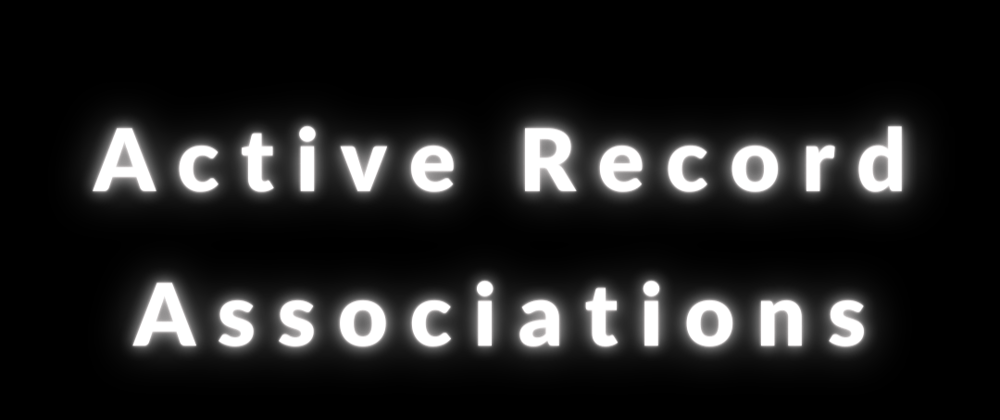As a programmer, understanding how to work with databases is crucial for building robust web applications. One fundamental concept in database management is Active Record associations. In this beginner's guide, we'll explore the world of Active Record associations, how they simplify data relationships, and how to use them effectively in your Ruby on Rails applications.
What are Active Record Associations?
Active Record Associations define relationships between database tables/models.
They enable you to create connections such as one-to-one, one-to-many, and many-to-many between different models.
Associations provide methods to retrieve and manipulate associated data, simplifying complex database queries.
One-to-One Associations:
One-to-One relationships exist when a record in one table is associated with exactly one record in another table.
Explore examples like User and Profile models, where a User has one Profile.
Learn how to define a one-to-one association using the
has_oneandbelongs_tomethods in Rails.
# app/models/user.rb
class User < ApplicationRecord
has_one :profile
end
# app/models/profile.rb
class Profile < ApplicationRecord
belongs_to :user
end
One-to-Many Associations:
One-to-Many relationships occur when a record in one table is associated with multiple records in another table.
Examine scenarios like User and Post models, where a User can have multiple Posts.
Discover how to define a one-to-many association using the
has_manyandbelongs_tomethods in Rails.Explore additional features like dependent options (e.g.,
dependent: :destroy) and foreign key customization.
# app/models/user.rb
class User < ApplicationRecord
has_many :posts
end
# app/models/post.rb
class Post < ApplicationRecord
belongs_to :user
end
Many-to-Many Associations:
Many-to-Many relationships are used when multiple records in one table are associated with multiple records in another table.
Discuss examples like User and Role models, where a User can have many Roles, and a Role can have many Users.
Understand how to define a many-to-many association using the
has_many :throughmethod in Rails.Explore the concept of a join table and how it facilitates the relationship between models.
# app/models/user.rb
class User < ApplicationRecord
has_many :user_roles
has_many :roles, through: :user_roles
end
# app/models/role.rb
class Role < ApplicationRecord
has_many :user_roles
has_many :users, through: :user_roles
end
# app/models/user_role.rb
class UserRole < ApplicationRecord
belongs_to :user
belongs_to :role
end
Querying and Eager Loading with Associations:
Learn how to retrieve associated data efficiently using methods like
joins,includes, andeager_load.Understand the difference between eager loading and lazy loading.
Explore examples of querying and manipulating associated data using ActiveRecord methods.
Best Practices and Common Pitfalls:
Gain insights into best practices for naming associations, table structures, and model relationships.
Discuss potential pitfalls like circular dependencies and the necessity of indexing foreign keys.
Understand the importance of testing and validating your associations.
Here are some code snippets illustrating best practices and common pitfalls when working with Active Record associations:
Best Practice: Naming Conventions
It's important to follow Rails' naming conventions for associations and foreign keys.
# Good example
class User < ApplicationRecord
has_many :posts
end
class Post < ApplicationRecord
belongs_to :user
end
Common Pitfall: Missing Index on Foreign Key
Adding an index on foreign keys can significantly improve query performance.
# Migration file
class AddIndexToPosts < ActiveRecord::Migration[6.1]
def change
add_index :posts, :user_id
end
end
Best Practice: Validations
Apply necessary validations to maintain data integrity in your associations.
class User < ApplicationRecord
has_many :posts
validates :username, presence: true, uniqueness: true
end
class Post < ApplicationRecord
belongs_to :user
validates :title, presence: true
end
Common Pitfall: Inefficient Queries
Avoid inefficient queries by selecting only the necessary fields when working with associations.
# Bad example (selecting all fields)
@users = User.includes(:posts).all
@users.each do |user|
user.posts.each do |post|
puts post.title
puts post.content
puts post.created_at
# ...
end
end
# Good example (selecting specific fields)
@users = User.includes(:posts).select(:id, :username)
@users.each do |user|
user.posts.each do |post|
puts post.title
end
end
As you can see, by following these best practices and avoiding common pitfalls, you'll ensure your Active Record associations are well-structured, efficient, and maintainable. Understanding how to define and utilize associations is essential for building dynamic and interconnected web applications with Ruby on Rails. By leveraging Active Record associations, you can simplify complex data relationships and unlock the full power of your database.
Happy coding!







Top comments (0)